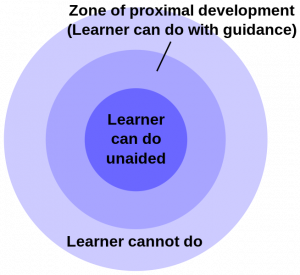1930s: Vygotsky
Ana R. Leon; Jennfier Paris; Antoinette Ricardo; Dawn Rymond; and Diana Lang
Vygotsky: Sociocultural Theory
Lev Vygotsky believed that a person has both a set of abilities and a set of potential abilities that can be reached if given the proper guidance from others.[1]

His Sociocultural Theory emphasizes the importance of culture and interaction in the development of cognitive abilities. Vygotsky concentrated more on children’s immediate social and cultural environment and their interactions with adults and peers. He saw a child as more of an apprentice, learning through a social environment with others who had more experience and were sensitive to the child’s needs and abilities.
Vygotsky theorized that through guided participation with a teacher or a more capable person, also known as scaffolding, a child can learn cognitive skills within a certain range known as the zone of proximal development. According to Vygotsky, development occurs first through children’s immediate social interactions and then moves to the individual level as they began to internalize their learning.
Lev Vygotsky’s Zone of Proximal Development

Have you ever taught children how to perform a task? Maybe it was brushing their teeth or tying their shoestrings. Chances are you spoke to them and described what you were doing while you demonstrated the skill and let them work along with you throughout the process. You provided them assistance when they seemed to need it, but once they knew what to do, you stood back and let them perform the task alone. This is an example of scaffolding.[2]
Examples of scaffolding, the temporary support that parents, peers or teachers give a child to perform a task, can be seen throughout the world in an unlimited number of situations. Vygotsky’s theory contends that instead of assessing what people are doing, people should be understood in terms of what they are capable of doing with the proper guidance. This approach to teaching has also been adopted by educators.
An example of the zone of proximal development can be seen in how to tie your shoes.

The zone of proximal development (ZPD) is the distance between a child’s potential to learn and the actual learning that takes place. Vygotsky hypothesized that a “quality teacher” first identifies a child’s ZPD and then helps the child learn beyond their ZPD.[3]
After this, the teacher (or any person with more advanced skills) gradually withdraws support until the child can perform the task without assistance. At this point, the child has reached a new developmental level and can begin progressing further in their studies.
Of course, this learning and teaching can occur with people of all ages and skill levels.
- Culture and interactions are key to the development of cognitive abilities.
- Scaffolding—a process of teaching by explaining a process, demonstrating the process, and performing the process.
- Zone of proximal development—the distance between a person’s potential to learn and their actual learning.
- This chapter is an adaptation of Child Growth and Development by Paris, Ricardo, and Rymond, and is used under a CC BY 4.0 license. ↵
- This section is an adaptation of Children’s Development by Ana R. Leon, used under a CC BY 4.0. license. ↵
- Vygotsky, L. (1978). Mind in society: The development of higher psychological processes. Harvard University Press. ↵
The temporary support that parents, peers or teachers give a child to help the child perform a task.

